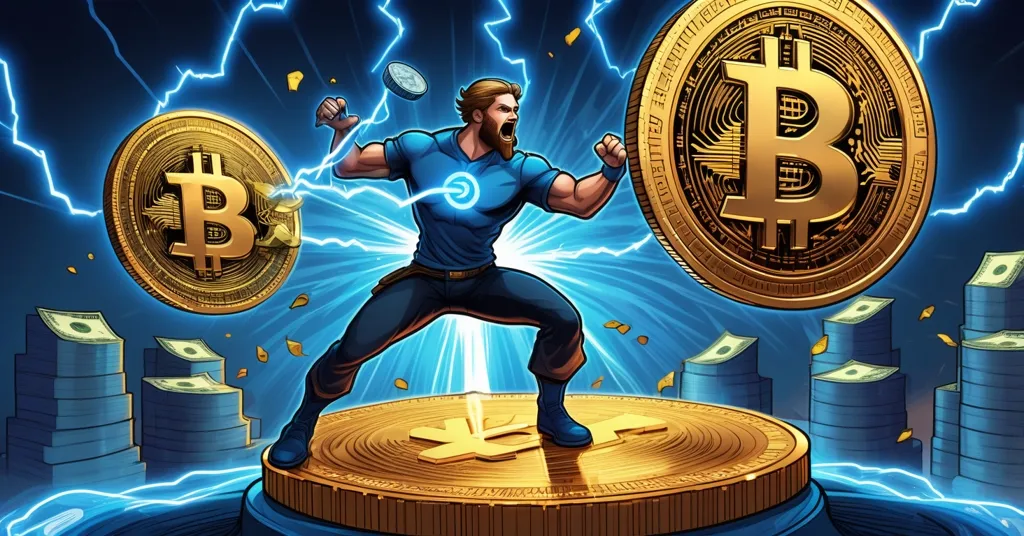XRP Faces $2.60 Resistance Battle as Bitcoin Hyper Raises $25.5M in Presale

XRP on the Edge: Can It Smash $2.60 Resistance or Will It Crumble? Plus, Bitcoin Hyper’s Bold Play
XRP is teetering at $2.55, eyeballing a make-or-break resistance at $2.60, while trading volume roars past $2.16 billion. The crypto crowd is split—will it surge to $3.00 or flop under pressure? Meanwhile, a new contender, Bitcoin Hyper ($HYPER), is turning heads with a $25.5 million presale as a Bitcoin Layer 2 solution on Solana. Let’s cut through the speculation, dissect the charts, and weigh whether these developments signal genuine progress or just more market noise.
- XRP Price Snapshot: Trading at $2.55, up 1.7% daily, with a $2.16B volume.
- Critical Levels: Resistance at $2.60 could lead to $3.00 if broken; support at $2.54 risks a drop to $2.02.
- Bitcoin Hyper Buzz: A Bitcoin L2 on Solana, raising $25.5M in presale, promising speed and scalability.
XRP’s High-Stakes Moment: Breakthrough or Breakdown?
XRP, holding down the fourth spot among cryptocurrencies with a hefty $153 billion market cap, is no stranger to the spotlight—or the drama. Tied to Ripple, this token has been both hailed as a game-changer for cross-border payments and slammed as a centralized oddity in the decentralized crypto world. Ripple’s ongoing legal battle with the SEC over whether XRP is a security continues to cast a shadow, even if it’s not directly driving today’s price action. For many, XRP represents a bridge between traditional finance and blockchain, with partnerships like those with financial institutions for remittance services adding to its allure. Yet, for Bitcoin purists, its centralized structure—Ripple holds a significant chunk of the supply—remains a bitter pill.
Right now, though, the focus is on the price. At $2.55, XRP is dancing just below a stubborn resistance level of $2.60. If it punches through with conviction, we could see a rally toward $3.00, maybe even $3.15—a psychological win that would likely spark a flood of FOMO-driven retail buying. But if it stumbles and fails to hold the nearby support at $2.54, the floor could drop to $2.26, or worse, $2.02. That’s a near 20% slide from current levels, the kind of gut punch that wipes out over-leveraged traders in a heartbeat. With a daily trading volume exceeding $2.16 billion, there’s plenty of liquidity fueling this tug-of-war, but volume alone doesn’t pick a winner. For deeper insights into XRP’s potential trajectory, check out this analysis on XRP’s resistance challenge and possible move to $3.00.
Some context for newer readers: XRP has seen similar price battles before. Back in late 2020, it flirted with levels near $0.70 before regulatory woes tanked it. The current $2.55 range is a far cry from its all-time high of $3.40 in January 2018, but it’s still a significant recovery. Whether this momentum holds depends not just on charts but on sentiment—news of a Ripple win against the SEC or a major adoption deal could ignite a rally. Until then, it’s a waiting game, and traders need to keep their heads on a swivel.
Chart Talk: Is XRP Bullish or Bearish?
Let’s dive into the technicals, because in crypto, the charts often dictate the narrative more than fundamentals. On the daily timeframe, XRP is caught in a descending triangle—a pattern where the price keeps getting squeezed with lower highs while clinging to a flat support line, kind of like a tightening vise. This setup typically hints at a bearish continuation, meaning sellers might be gaining the upper hand. If that $2.54 support cracks, expect a swift move downward to those $2.26 or $2.02 targets I mentioned. It’s not a pretty picture for the bulls.
Other indicators aren’t exactly screaming optimism either. XRP is trading below its 50-day Exponential Moving Average (EMA), a line often used to gauge short-term trends. Being under it suggests the bears have the momentum. The Relative Strength Index (RSI), which measures whether an asset is overbought or oversold, sits at a tepid 48—smack in neutral territory but showing signs of bearish divergence. In plain terms, buying interest might be drying up even as the price holds steady, a warning sign for a potential drop. Zooming out to the weekly chart, resistance at $2.60 has historically been a tough nut to crack, with multiple failed attempts over the past year. Without a surge in volume to back a breakout, any push higher could fizzle into a trap for eager buyers.
That said, crypto markets love to defy logic. A strong close above $2.60, especially with volume spiking past $3 billion daily, could flip this bearish script and send XRP toward $3.00. On-chain data from platforms like CoinGecko shows transaction activity remaining robust, with daily transfers often exceeding $1 billion in value, suggesting underlying demand persists. But let’s not get carried away—price predictions in this space are a gamble, not a science. Anyone claiming XRP is “guaranteed” to hit $3.00 is either clueless or straight-up shilling. Markets are swayed by whale moves, sudden news, and pure emotion. Trade with caution, not blind hope.
Bitcoin Hyper: A Scalability Gambit Worth Watching?
Shifting focus, there’s another development that ties into the broader push for blockchain innovation. Bitcoin Hyper ($HYPER) is pitching itself as the first Bitcoin-native Layer 2 solution built on the Solana Virtual Machine (SVM). For those just dipping their toes into crypto, a Layer 2 is like adding express lanes to a clogged highway—Bitcoin’s main blockchain often struggles with slow transaction speeds (around 7 transactions per second) and high fees, especially during peak usage. Layer 2 solutions process transactions off the main chain while still leveraging Bitcoin’s rock-solid security, aiming to make the network more usable for everyday stuff.
Bitcoin Hyper’s angle is merging Bitcoin’s trustless foundation with Solana’s blistering speed—Solana can handle up to 65,000 transactions per second at a fraction of the cost. The idea is to enable low-cost smart contracts, decentralized apps (dApps), and even quirky use cases like meme coin creation, all tied to Bitcoin’s ecosystem. Their presale has already pulled in over $25.5 million, with tokens priced at $0.013205, showing serious early investor appetite. Audited by Consult, the project is framing itself as a bridge between two heavyweight blockchains, potentially unlocking new utility for Bitcoin without tampering with its core.
Before we pop the champagne, let’s pump the brakes. The crypto graveyard is packed with shiny presale projects that promised the moon and delivered dust. Raising $25.5 million is a nice headline, but it’s no proof of long-term viability. Combining Bitcoin’s security with Solana’s tech sounds great on paper, but cross-chain integrations are notoriously tricky—security flaws or exploits could tank the project before it even gets off the ground. And Solana itself isn’t flawless; it’s had network outages in the past, raising questions about reliability. Then there’s the meme coin focus—while it’s a hot trend, it often reeks of speculative nonsense rather than real value. Still, the concept of enhancing Bitcoin’s scalability is exciting, especially for those of us who see Bitcoin as the ultimate decentralized asset. Compared to other Bitcoin Layer 2s like the Lightning Network, which focuses on payments, or Stacks, which enables smart contracts, Bitcoin Hyper’s Solana integration is a bold experiment. If it works, it could expand Bitcoin’s reach into DeFi and beyond. If it flops, it’s just another cautionary tale.
The Bigger Picture: Altcoins, Bitcoin, and the Road to Freedom
Stepping back, XRP’s price showdown and Bitcoin Hyper’s ambitious play are microcosms of the broader crypto revolution. Bitcoin remains the undisputed king—the bedrock of decentralization, privacy, and financial freedom. No altcoin matches its network security or its ethos of trustless money. Yet, I’m not blind to the reality that altcoins like XRP serve niches Bitcoin doesn’t touch. XRP’s speed and low-cost transactions make it a contender for cross-border payments, even if its centralized baggage grates on purists. Similarly, projects like Bitcoin Hyper, while risky, embody the spirit of effective accelerationism—pushing boundaries through experimentation, even if half the attempts crash and burn.
As champions of disrupting the status quo, we cheer these innovations, but with eyes wide open. XRP’s $3.00 dreams could easily turn into a $2.00 nightmare, and Bitcoin Hyper might join the long list of presale flops. Our job isn’t to peddle hopium or shill moonshots. It’s to sift through the hype, expose the scams, and highlight what might actually shift the needle toward a freer financial system. So, as XRP battles its resistance and Bitcoin Hyper tests uncharted waters, a bigger question looms: are these detours diluting Bitcoin’s purity, or are they messy but necessary steps toward mass adoption?
Key Questions and Takeaways
- What’s driving XRP’s price action right now?
XRP is at $2.55, up 1.7% daily, stuck below a $2.60 resistance and above a $2.54 support, with technical patterns leaning bearish but a breakout still possible. - Is a $3.00 target for XRP realistic?
It’s achievable if $2.60 breaks with high volume, but bearish signals like the descending triangle and market volatility make it a risky bet, not a sure thing. - What are the downside risks for XRP?
If support at $2.54 fails, prices could slide to $2.26 or $2.02, exacerbated by broader market swings or negative news around Ripple’s legal issues. - Why does Bitcoin Hyper ($HYPER) matter?
As a Bitcoin Layer 2 on Solana, it aims to blend Bitcoin’s security with Solana’s speed for dApps and smart contracts, addressing Bitcoin’s scalability woes with a $25.5M presale. - Should you jump on Bitcoin Hyper’s presale hype?
Proceed with skepticism—while the idea is promising, many presale projects fail due to technical issues or lack of delivery. Research and risk management are non-negotiable. - How do XRP and Bitcoin Hyper fit into the crypto revolution?
XRP fills a payment niche despite centralization concerns, while Bitcoin Hyper experiments with Bitcoin’s utility. Both push innovation, but Bitcoin remains the gold standard for decentralization.



